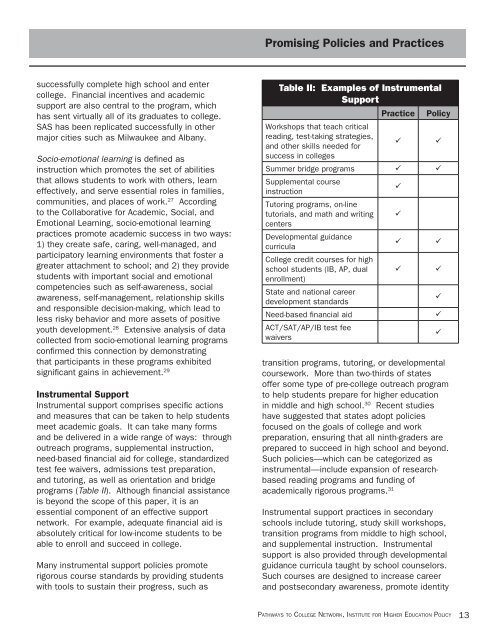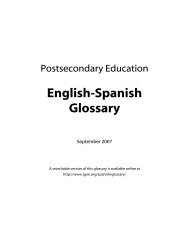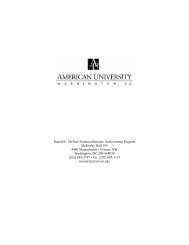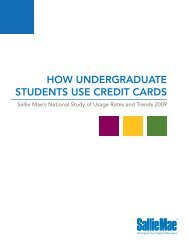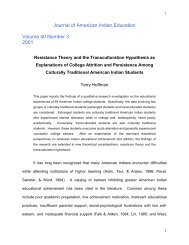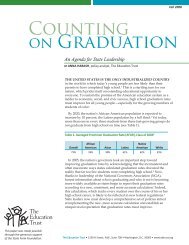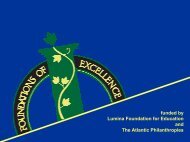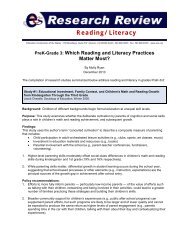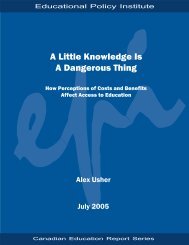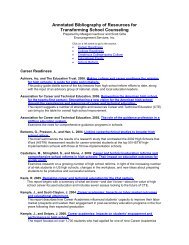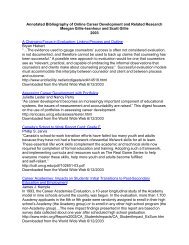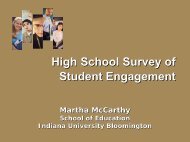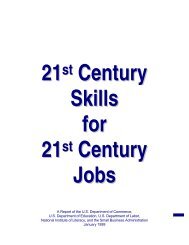Removing Roadblocks to Rigor: Linking Academic and Social ...
Removing Roadblocks to Rigor: Linking Academic and Social ...
Removing Roadblocks to Rigor: Linking Academic and Social ...
You also want an ePaper? Increase the reach of your titles
YUMPU automatically turns print PDFs into web optimized ePapers that Google loves.
Promising Policies <strong>and</strong> Practices<br />
successfully complete high school <strong>and</strong> enter<br />
college. Financial incentives <strong>and</strong> academic<br />
support are also central <strong>to</strong> the program, which<br />
has sent virtually all of its graduates <strong>to</strong> college.<br />
SAS has been replicated successfully in other<br />
major cities such as Milwaukee <strong>and</strong> Albany.<br />
Socio-emotional learning is defined as<br />
instruction which promotes the set of abilities<br />
that allows students <strong>to</strong> work with others, learn<br />
effectively, <strong>and</strong> serve essential roles in families,<br />
communities, <strong>and</strong> places of work. 27 According<br />
<strong>to</strong> the Collaborative for <strong>Academic</strong>, <strong>Social</strong>, <strong>and</strong><br />
Emotional Learning, socio-emotional learning<br />
practices promote academic success in two ways:<br />
1) they create safe, caring, well-managed, <strong>and</strong><br />
participa<strong>to</strong>ry learning environments that foster a<br />
greater attachment <strong>to</strong> school; <strong>and</strong> 2) they provide<br />
students with important social <strong>and</strong> emotional<br />
competencies such as self-awareness, social<br />
awareness, self-management, relationship skills<br />
<strong>and</strong> responsible decision-making, which lead <strong>to</strong><br />
less risky behavior <strong>and</strong> more assets of positive<br />
youth development. 28 Extensive analysis of data<br />
collected from socio-emotional learning programs<br />
confirmed this connection by demonstrating<br />
that participants in these programs exhibited<br />
significant gains in achievement. 29<br />
Instrumental Support<br />
Instrumental support comprises specific actions<br />
<strong>and</strong> measures that can be taken <strong>to</strong> help students<br />
meet academic goals. It can take many forms<br />
<strong>and</strong> be delivered in a wide range of ways: through<br />
outreach programs, supplemental instruction,<br />
need-based financial aid for college, st<strong>and</strong>ardized<br />
test fee waivers, admissions test preparation,<br />
<strong>and</strong> tu<strong>to</strong>ring, as well as orientation <strong>and</strong> bridge<br />
programs (Table II). Although financial assistance<br />
is beyond the scope of this paper, it is an<br />
essential component of an effective support<br />
network. For example, adequate financial aid is<br />
absolutely critical for low-income students <strong>to</strong> be<br />
able <strong>to</strong> enroll <strong>and</strong> succeed in college.<br />
Many instrumental support policies promote<br />
rigorous course st<strong>and</strong>ards by providing students<br />
with <strong>to</strong>ols <strong>to</strong> sustain their progress, such as<br />
Table II: Examples of Instrumental<br />
Support<br />
Practice Policy<br />
Workshops that teach critical<br />
reading, test-taking strategies,<br />
<strong>and</strong> other skills needed for<br />
¸ ¸<br />
success in colleges<br />
Summer bridge programs ¸ ¸<br />
Supplemental course<br />
instruction<br />
¸<br />
Tu<strong>to</strong>ring programs, on-line<br />
tu<strong>to</strong>rials, <strong>and</strong> math <strong>and</strong> writing ¸<br />
centers<br />
Developmental guidance<br />
curricula<br />
¸ ¸<br />
College credit courses for high<br />
school students (IB, AP, dual ¸ ¸<br />
enrollment)<br />
State <strong>and</strong> national career<br />
development st<strong>and</strong>ards<br />
¸<br />
Need-based financial aid<br />
¸<br />
ACT/SAT/AP/IB test fee<br />
waivers<br />
¸<br />
transition programs, tu<strong>to</strong>ring, or developmental<br />
coursework. More than two-thirds of states<br />
offer some type of pre-college outreach program<br />
<strong>to</strong> help students prepare for higher education<br />
in middle <strong>and</strong> high school. 30 Recent studies<br />
have suggested that states adopt policies<br />
focused on the goals of college <strong>and</strong> work<br />
preparation, ensuring that all ninth-graders are<br />
prepared <strong>to</strong> succeed in high school <strong>and</strong> beyond.<br />
Such policies—which can be categorized as<br />
instrumental—include expansion of researchbased<br />
reading programs <strong>and</strong> funding of<br />
academically rigorous programs. 31<br />
Instrumental support practices in secondary<br />
schools include tu<strong>to</strong>ring, study skill workshops,<br />
transition programs from middle <strong>to</strong> high school,<br />
<strong>and</strong> supplemental instruction. Instrumental<br />
support is also provided through developmental<br />
guidance curricula taught by school counselors.<br />
Such courses are designed <strong>to</strong> increase career<br />
<strong>and</strong> postsecondary awareness, promote identity<br />
PATHWAYS TO COLLEGE NETWORK, INSTITUTE FOR HIGHER EDUCATION POLICY<br />
13


